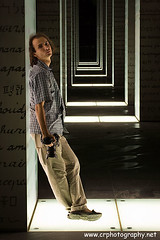November 22nd, Huay Pu Keng Village, Thailand
The village, some 190 heads strong, has no road (access is by boat only), no electricity (except for a diesel generator for special occasions and a solar panel to charge batteries) and only the most elementary plumbing. It is inhabited by people of two tribes famous for the unusual customs of their women, the 'long-neck' Kayen and the 'big-ear' Kayew. The women of the first tribe wear brass coils around their necks. They start at the age of 5 with a 1kg coil and increase the weight of the coil by 1kg every few years up to 6kg. The weight and eventually the length of the coil pushes the shoulders down deforming their bone structure as they grow, causing them to appear as if they have unusually long necks. They never take the coils off except when changing to a longer, heavier coil. The women of the other tribe force increasingly larger rings into their pierced ear-lobes. They also start at the age of 5 increasing the diameter of the rings over time with the largest ring exceeding two inches in diameter. There are three villages in the Mae Hong Son vicinity inhabited by the two tribes and most tourists stop for a quick picture in one of them before moving on. I was fortunate enough to visit all three, eventually spending two days and two nights living in the smallest one. At first sight the tribes would appear to be better off than others in the area being heavily visited by tourists doing the Mae Hong Son loop. When you talk to the villagers you find out what the guide books don't tell you. The Kayen are refugees from Burma and are essentially living under indefinite house arrest. They're not allowed to work in Thailand other than to produce and sell their simple crafts in their villages. The Thai government will not issue them with identity cards and they're not allowed to travel. This is enforced by the many military and police checkpoints in the ares (my car was inspected several times). No-one I spoke to has ever been further than the town of Mae Hong Son, only 15km away. Still, their situation is much better than that of the Kayen living in refugee camps (off limits to visitors) and those still living under persecution in Burma. They are extremely proud of their tradition and who they are and do the best with what they have. I was most impressed with their little school where all the children are taught and speak four languages: Kayen, Burmese, Thai and English. Living in the village, even for such a short time, was a beautiful experience and I am forever grateful to the people of Keyen for their hospitality.

1 Comments:
Fantastic. Thanks for that info ... hopefully we will make it there too next month.
Post a Comment
<< Home